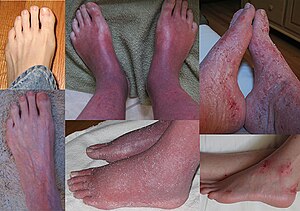Erythroderma
| Erythroderma | |
|---|---|
 |
|
| Red Skin Syndrome | |
| Classification and external resources | |
| Specialty | dermatology |
| ICD-10 | L26, L53.9 |
| ICD-9-CM | 695.9 |
| DiseasesDB | 29735 |
| MedlinePlus | 001610 |
| eMedicine | derm/142 |
| MeSH | D003873 |
Erythroderma (also known as "Exfoliative dermatitis," "Dermatitis exfoliativa") is an inflammatory skin disease with erythema and scaling that affects nearly the entire cutaneous surface.
In ICD-10, a distinction is made between "exfoliative dermatitis" at L26, and "erythroderma" at L53.9.
Erythroderma is generalized exfoliative dermatitis, which involves 90% or more of the patient's skin. The most common cause of erythroderma is exacerbation of an underlying skin disease, such as psoriasis, contact dermatitis, seborrheic dermatitis, lichen planus, pityriasis rubra pilaris or a drug reaction. Primary erythroderma is less frequent and is usually seen in cases of cutaneous T-cell lymphoma, in particular in Sézary's disease.
The most common causes of exfoliative dermatitis are best remembered by the mnemonic device ID-SCALP. The causes and their frequencies are as follows:
Differential diagnosis in patients with erythroderma may be difficult.
You have to treat the primary cause or the exacerbation may persisist and reincide. Topical steroids are the primary category of medications used to treat exfoliative dermatitis (ED). A sedative antihistamine may be a useful adjunct for pruritic patients, since it helps patients to sleep at night, thus limiting nocturnal scratching and excoriations. Antimicrobial agents often are used if an infection is suspected to be precipitating or complicating exfoliative dermatitis. Other drugs specifically indicated for management of underlying cause of exfoliative dermatitis may be necessary.
The classification of exfoliative dermatitis into Wilson-Brocq (chronic relapsing), Hebra or pityriasis rubra (progressive), and Savill (self-limited) types may have had historical value, but it currently lacks pathophysiologic or clinical utility.
...
Wikipedia
